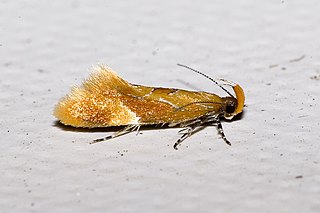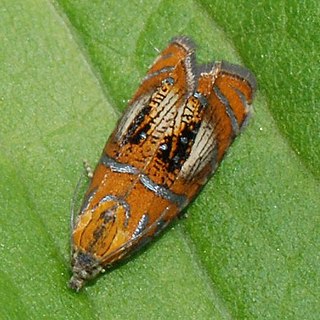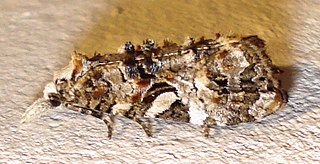| Phtheochroa rugosana | |
|---|---|
 | |
| Adult from Lincolnshire, UK | |
| Scientific classification | |
| Kingdom: | Animalia |
| Phylum: | Arthropoda |
| Class: | Insecta |
| Order: | Lepidoptera |
| Family: | Tortricidae |
| Tribe: | Cochylini |
| Genus: | Phtheochroa |
| Species: | P. rugosana |
| Binomial name | |
| Phtheochroa rugosana (Hübner, [1799]) | |
| Synonyms | |
See text | |
Phtheochroa rugosana is a small moth of the family Tortricidae.

Moths comprise a group of insects related to butterflies, belonging to the order Lepidoptera. Most lepidopterans are moths, and there are thought to be approximately 160,000 species of moth, many of which have yet to be described. Most species of moth are nocturnal, but there are also crepuscular and diurnal species.
Family is one of the eight major hierarchical taxonomic ranks in Linnaean taxonomy; it is classified between order and genus. A family may be divided into subfamilies, which are intermediate ranks between the ranks of family and genus. The official family names are Latin in origin; however, popular names are often used: for example, walnut trees and hickory trees belong to the family Juglandaceae, but that family is commonly referred to as being the "walnut family".

The Tortricidae are a family of moths, commonly known as tortrix moths or leafroller moths, in the order Lepidoptera. This large family has over 10,350 species described, and is the sole member of the superfamily Tortricoidea, although the genus Heliocosma is sometimes placed within this superfamily. Many of these are economically important pests. Olethreutidae is a junior synonym. The typical resting posture is with the wings folded back, producing a rather rounded profile.
Contents
It is found in western Europe (Iberian Peninsula, France and the British Isles) east to the Benelux, Switzerland and Italy, and further across the Balkans and Hungary to Asia Minor and Armenia. It also occurs in the Maghreb (possibly excluding Tunisia) and on the Canary Islands. [1]

The Iberian Peninsula, also known as Iberia, is located in the southwest corner of Europe. The peninsula is principally divided between Spain and Portugal, comprising most of their territory. It also includes Andorra, small areas of France, and the British overseas territory of Gibraltar. With an area of approximately 596,740 square kilometres (230,400 sq mi)), it is both the second largest European peninsula by area, after the Scandinavian Peninsula, and by population, after the Balkan Peninsula.

France, officially the French Republic, is a country whose territory consists of metropolitan France in Western Europe and several overseas regions and territories. The metropolitan area of France extends from the Mediterranean Sea to the English Channel and the North Sea, and from the Rhine to the Atlantic Ocean. It is bordered by Belgium, Luxembourg and Germany to the northeast, Switzerland and Italy to the east, and Andorra and Spain to the south. The overseas territories include French Guiana in South America and several islands in the Atlantic, Pacific and Indian oceans. The country's 18 integral regions span a combined area of 643,801 square kilometres (248,573 sq mi) and a total population of 67.3 million. France, a sovereign state, is a unitary semi-presidential republic with its capital in Paris, the country's largest city and main cultural and commercial centre. Other major urban areas include Lyon, Marseille, Toulouse, Bordeaux, Lille and Nice.

The British Isles are a group of islands in the North Atlantic off the north-western coast of continental Europe that consist of the islands of Great Britain, Ireland, the Isle of Man, the Hebrides and over six thousand smaller isles. They have a total area of about 315,159 km2 and a combined population of almost 72 million, and include two sovereign states, the Republic of Ireland, and the United Kingdom of Great Britain and Northern Ireland. The islands of Alderney, Jersey, Guernsey, and Sark, and their neighbouring smaller islands, are sometimes also taken to be part of the British Isles, even though, as islands off the coast of France, they do not form part of the archipelago.
The wingspan is 18–23 mm. Adults are on wing from May to July. There is one generation per year.

The wingspan of a bird or an airplane is the distance from one wingtip to the other wingtip. For example, the Boeing 777-200 has a wingspan of 60.93 metres, and a wandering albatross caught in 1965 had a wingspan of 3.63 metres, the official record for a living bird. The term wingspan, more technically extent, is also used for other winged animals such as pterosaurs, bats, insects, etc., and other fixed-wing aircraft such as ornithopters. In humans, the term wingspan also refers to the arm span, which is distance between the length from one end of an individual's arms to the other when raised parallel to the ground at shoulder height at a 90º angle. Former professional basketball player Manute Bol stands at 7 ft 7 in (2.31 m) and owns one of the largest wingspans at 8 ft 6 in (2.59 m).
A generation is "all of the people born and living at about the same time, regarded collectively". It can also be described as, "the average period, generally considered to be about thirty years, during which children are born and grow up, become adults, and begin to have children of their own". In kinship terminology, it is a structural term designating the parent-child relationship. It is also known as biogenesis, reproduction, or procreation in the biological sciences.
The caterpillars feed on red bryony ( Bryonia dioica ) and probably also squirting cucumber ( Ecballium elaterium ). More unusually, they have been recorded eating rotting wood. [2]

Caterpillars are the larval stage of members of the order Lepidoptera.

Bryonia dioica, known by the common names red bryony and white bryony, also English mandrake or ladies' seal, is a perennial climbing vine indigenous to Central and Southern Europe. It is a flowering plant in the cucumber family Cucurbitaceae with five-pointed leaves and blue or white flowers. The vine produces a red berry fruit.



















